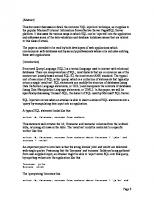Expert Performance Indexing in Azure SQL and SQL Server 2022: Toward Faster Results and Lower Maintenance Both on Premises and in the Cloud [4 ed.] 1484292146, 9781484292143
Take a deep dive into perhaps the single most important facet of query performance―indexes―and how to best use them. New
313 51 14MB
English Pages 659 [649] Year 2023
Table of contents :
Table of Contents
About the Authors
About the Technical Reviewer
Acknowledgments
Introduction
Chapter 1: Index Fundamentals
Why Build Indexes?
Major Index Types
Heap Tables
Clustered Indexes
Non-clustered Indexes
Other Index Types
Columnstore Indexes
JSON and XML Indexes
Spatial Indexes
Hash and Range Indexes
Full-Text Search
Index Variations
Primary Key
Unique Index
Included Columns
Partitioned Indexes
Filtered Indexes
Compression and Indexing
Index Data Definition Language
Creating an Index
Altering an Index
Dropping an Index
Index Metadata
sys.indexes
sys.index_columns
sys.index_resumable_operations
sys.xml_indexes
sys.selective_xml_index_paths
sys.selective_xml_index_namespaces
sys.spatial_indexes
sys.spatial_index_tessellations
sys.column_store_dictionaries
sys.column_store_segments
sys.column_store_row_groups
sys.hash_indexes
sys.fulltext_catalogs
sys.fulltext_indexes
sys.fulltext_index_columns
Summary
Chapter 2: Index Storage Fundamentals
Storage Basics
Pages
Extents
Page Types
File Header Page
Boot Page
Page Free Space Page
Global Allocation Map Page
Shared Global Allocation Map Page
Differential Changed Map Page
Minimally Logged Page
Index Allocation Map Page
Data Page
Index Page
Large Object Page
Organizing Pages
Heap Structure
B-Tree Structure
Columnstore Structure
Minimally Logged Bulk-Loading Data
The Deltastore
The Delete Bitmap
Index Characteristics
Heap
Clustered Index
Non-clustered Index
Columnstore Index
Summary
Chapter 3: Examining Index Contents
Examining Pages
Dynamic Management Functions
sys.dm_db_database_page_allocations
sys.dm_db_page_info
DBCC Commands
DBCC EXTENTINFO
DBCC IND
DBCC PAGE
Page Header–Only Print Option
Hex Rows Print Option
Hex Data Print Option
Row Data Print Option
Summary
Chapter 4: Fragmentation
Page Fragmentation
Forwarded Records
Page Splits
Summary
Chapter 5: Index Metadata and Statistics
Column-Level Statistics
DBCC SHOW_STATISTICS
Stats Header
Density Vector
Histogram
Catalog Views
sys.stats
sys.stats_columns
STATS_DATE
sys.dm_db_stats_properties
sys.dm_db_stats_histogram
sys.dm_db_incremental_stats_properties
Statistics DDL
Column-Level Statistics Summary
Index Usage Statistics
Header Columns
User Columns
System Columns
Index Usage Stats Summary
Index Operational Statistics
Header Columns
DML Activity
SELECT Activity
Range Scan
Singleton Lookup
Forwarded Fetch
Locking Contention
Row Lock
Page Lock
Lock Escalation
Latch Contention
Page I/O Latch
Page Latch
Page Allocation Cycle
Compression
LOB Access
Row Version
Index Operational Stats Summary
Index Physical Statistics
Header Columns
Row Statistics
Fragmentation Statistics
Index Physical Stats Summary
Columnstore Statistics
Columnstore Physical Stats
Header Columns
Statistics Columns
Columnstore Operational Stats
Header Columns
Statistics Columns
Summary
Untitled
Untitled
Chapter 6: XML Indexes
XML Data
Benefits
Cautions
XML Indexes
Primary/Secondary XML Indexes
Primary XML Index
Secondary XML Index
Selective XML Indexes
Summary
Chapter 7: Spatial Indexing
How Spatial Data Is Indexed
Creating Spatial Indexes
Supporting Methods with Indexes
Understanding Statistics, Properties, and Information
The Views
Stored Procedures
Tuning Spatial Indexes
Restrictions on Spatial Indexes
Summary
Chapter 8: Indexing Memory-Optimized Tables
Memory-Optimized Tables Overview
Hash Indexes
Range Indexes
Summary
Chapter 9: Full-Text Indexing
Full-Text Indexing
Creating a Full-Text Example
Creating a Full-Text Catalog
Creating a Full-Text Index
Syntax
Key Indexes
Population
StopLists
Full-Text Search Index Catalog Views and Properties
Summary
Chapter 10: Indexing Myths and Best Practices
Index Myths
Myth 1: Databases Do Not Need Indexes
Myth 2: Primary Keys Are Always Clustered
Myth 3: Online Index Operations Don’t Block
Myth 4: Any Column Can Be Filtered in Multicolumn Indexes
Myth 5: Clustered Indexes Store Records in Physical Order
Myth 6: Indexes Always Output Rows in the Same Order
Myth 7: Fill Factor Is Applied to Indexes During Inserts
Myth 8: Deleting from Heaps Results in Unrecoverable Space
Myth 9: Every Table Should Have a Heap/Clustered Index
Index Best Practices
Index to the Current Workload
Use Clustered Indexes on Primary Keys by Default
Specify Fill Factors
Database-Level Fill Factor
Index-Level Fill Factor
Index Foreign Key Columns
Balance Index Count
Summary
Chapter 11: Index Maintenance
Index Fragmentation
Fragmentation Operations
Insert Operations
Update Operations
Delete Operations
Shrink Operations
Fragmentation Variants
Heap Bloat and Forwarding
Columnstore Fragmentation
Fragmentation Issues
Index I/O
Contiguous Reads
Defragmentation Options
Index Rebuild
Index Reorganization
Drop and Create
Defragmentation Strategies
Maintenance Plans
Reorganize Index Task
Rebuild Index Task
Maintenance Plan Summary
T-SQL Scripts
Preventing Fragmentation
Fill Factor
Data Typing
Default Values
Index Statistics Maintenance
Automatically Maintaining Statistics
Automatic Creation
Automatic Updating
Preventing Auto-update
Memory-Optimized Table Statistics
Manually Maintaining Statistics
Maintenance Plans
T-SQL Scripts
Stored Procedure
DDL Command
Summary
Untitled
Chapter 12: Indexing Tools
Missing Indexes
Explaining the DMOs
sys.dm_db_missing_index_details
sys.dm_db_missing_index_columns
sys.dm_db_missing_index_groups
sys.dm_db_missing_index_group_stats
Using the DMOs
Database Engine Tuning Advisor
Explaining the DTA
Using the DTA GUI
Using the DTA Utility
Summary
Chapter 13: Indexing Strategies
Heaps
Temporary Objects
Other Heap Scenarios
Clustered Indexes
Identity Sequence
Natural Key
Foreign Key
Multiple Column
Globally Unique Identifier
Non-clustered Indexes
Search Columns
Index Intersection
Multiple Column
Covering Index
Included Columns
Filtered Indexes
Foreign Keys
Columnstore Index
JSON Indexing
Index Storage Strategies
Row Compression
Page Compression
Indexed Views
Summary
Untitled
Chapter 14: Query Strategies
LIKE Comparison
Concatenation
Computed Columns
Scalar Functions
Data Conversion
Summary
Chapter 15: Monitoring Indexes
Performance Counters
Dynamic Management Objects
Index Usage Stats
Index Operational Stats
Index Physical Stats
Wait Statistics
Data Cleanup
Event Tracing
SQL Trace
Extended Events
Query Store
Summary
Chapter 16: Index Analysis
Review of Server State
Performance Counters
Forwarded Records per Second
FreeSpace Scans and Page Fetches per Second
Full Scans per Second
Index Searches per Second
Page Splits per Second
Page Lookups per Second
Page Compression
Lock Wait Time
Lock Waits per Second
Number of Deadlocks per Second
Wait Statistics
CXPACKET
IO_COMPLETION
LCK_M_∗
PAGEIOLATCH_∗
Buffer Allocation
Schema Discovery
Identify Heaps
Duplicate Indexes
Overlapping Indexes
Unindexed Foreign Keys
Uncompressed Indexes
Database Engine Tuning Advisor
Unused Indexes
Index Plan Usage
Summary
Chapter 17: Indexing Methodology
The Indexing Method
Implement
Communication
Impact Analysis
Status Report
Deployment Scripts
Prepare Deployment and Rollback of Schema
Save Index Changes to Source Code Repository
Peer Review with Impact Analysis
Execution
Repeat
Summary
Index
Table of Contents
About the Authors
About the Technical Reviewer
Acknowledgments
Introduction
Chapter 1: Index Fundamentals
Why Build Indexes?
Major Index Types
Heap Tables
Clustered Indexes
Non-clustered Indexes
Other Index Types
Columnstore Indexes
JSON and XML Indexes
Spatial Indexes
Hash and Range Indexes
Full-Text Search
Index Variations
Primary Key
Unique Index
Included Columns
Partitioned Indexes
Filtered Indexes
Compression and Indexing
Index Data Definition Language
Creating an Index
Altering an Index
Dropping an Index
Index Metadata
sys.indexes
sys.index_columns
sys.index_resumable_operations
sys.xml_indexes
sys.selective_xml_index_paths
sys.selective_xml_index_namespaces
sys.spatial_indexes
sys.spatial_index_tessellations
sys.column_store_dictionaries
sys.column_store_segments
sys.column_store_row_groups
sys.hash_indexes
sys.fulltext_catalogs
sys.fulltext_indexes
sys.fulltext_index_columns
Summary
Chapter 2: Index Storage Fundamentals
Storage Basics
Pages
Extents
Page Types
File Header Page
Boot Page
Page Free Space Page
Global Allocation Map Page
Shared Global Allocation Map Page
Differential Changed Map Page
Minimally Logged Page
Index Allocation Map Page
Data Page
Index Page
Large Object Page
Organizing Pages
Heap Structure
B-Tree Structure
Columnstore Structure
Minimally Logged Bulk-Loading Data
The Deltastore
The Delete Bitmap
Index Characteristics
Heap
Clustered Index
Non-clustered Index
Columnstore Index
Summary
Chapter 3: Examining Index Contents
Examining Pages
Dynamic Management Functions
sys.dm_db_database_page_allocations
sys.dm_db_page_info
DBCC Commands
DBCC EXTENTINFO
DBCC IND
DBCC PAGE
Page Header–Only Print Option
Hex Rows Print Option
Hex Data Print Option
Row Data Print Option
Summary
Chapter 4: Fragmentation
Page Fragmentation
Forwarded Records
Page Splits
Summary
Chapter 5: Index Metadata and Statistics
Column-Level Statistics
DBCC SHOW_STATISTICS
Stats Header
Density Vector
Histogram
Catalog Views
sys.stats
sys.stats_columns
STATS_DATE
sys.dm_db_stats_properties
sys.dm_db_stats_histogram
sys.dm_db_incremental_stats_properties
Statistics DDL
Column-Level Statistics Summary
Index Usage Statistics
Header Columns
User Columns
System Columns
Index Usage Stats Summary
Index Operational Statistics
Header Columns
DML Activity
SELECT Activity
Range Scan
Singleton Lookup
Forwarded Fetch
Locking Contention
Row Lock
Page Lock
Lock Escalation
Latch Contention
Page I/O Latch
Page Latch
Page Allocation Cycle
Compression
LOB Access
Row Version
Index Operational Stats Summary
Index Physical Statistics
Header Columns
Row Statistics
Fragmentation Statistics
Index Physical Stats Summary
Columnstore Statistics
Columnstore Physical Stats
Header Columns
Statistics Columns
Columnstore Operational Stats
Header Columns
Statistics Columns
Summary
Untitled
Untitled
Chapter 6: XML Indexes
XML Data
Benefits
Cautions
XML Indexes
Primary/Secondary XML Indexes
Primary XML Index
Secondary XML Index
Selective XML Indexes
Summary
Chapter 7: Spatial Indexing
How Spatial Data Is Indexed
Creating Spatial Indexes
Supporting Methods with Indexes
Understanding Statistics, Properties, and Information
The Views
Stored Procedures
Tuning Spatial Indexes
Restrictions on Spatial Indexes
Summary
Chapter 8: Indexing Memory-Optimized Tables
Memory-Optimized Tables Overview
Hash Indexes
Range Indexes
Summary
Chapter 9: Full-Text Indexing
Full-Text Indexing
Creating a Full-Text Example
Creating a Full-Text Catalog
Creating a Full-Text Index
Syntax
Key Indexes
Population
StopLists
Full-Text Search Index Catalog Views and Properties
Summary
Chapter 10: Indexing Myths and Best Practices
Index Myths
Myth 1: Databases Do Not Need Indexes
Myth 2: Primary Keys Are Always Clustered
Myth 3: Online Index Operations Don’t Block
Myth 4: Any Column Can Be Filtered in Multicolumn Indexes
Myth 5: Clustered Indexes Store Records in Physical Order
Myth 6: Indexes Always Output Rows in the Same Order
Myth 7: Fill Factor Is Applied to Indexes During Inserts
Myth 8: Deleting from Heaps Results in Unrecoverable Space
Myth 9: Every Table Should Have a Heap/Clustered Index
Index Best Practices
Index to the Current Workload
Use Clustered Indexes on Primary Keys by Default
Specify Fill Factors
Database-Level Fill Factor
Index-Level Fill Factor
Index Foreign Key Columns
Balance Index Count
Summary
Chapter 11: Index Maintenance
Index Fragmentation
Fragmentation Operations
Insert Operations
Update Operations
Delete Operations
Shrink Operations
Fragmentation Variants
Heap Bloat and Forwarding
Columnstore Fragmentation
Fragmentation Issues
Index I/O
Contiguous Reads
Defragmentation Options
Index Rebuild
Index Reorganization
Drop and Create
Defragmentation Strategies
Maintenance Plans
Reorganize Index Task
Rebuild Index Task
Maintenance Plan Summary
T-SQL Scripts
Preventing Fragmentation
Fill Factor
Data Typing
Default Values
Index Statistics Maintenance
Automatically Maintaining Statistics
Automatic Creation
Automatic Updating
Preventing Auto-update
Memory-Optimized Table Statistics
Manually Maintaining Statistics
Maintenance Plans
T-SQL Scripts
Stored Procedure
DDL Command
Summary
Untitled
Chapter 12: Indexing Tools
Missing Indexes
Explaining the DMOs
sys.dm_db_missing_index_details
sys.dm_db_missing_index_columns
sys.dm_db_missing_index_groups
sys.dm_db_missing_index_group_stats
Using the DMOs
Database Engine Tuning Advisor
Explaining the DTA
Using the DTA GUI
Using the DTA Utility
Summary
Chapter 13: Indexing Strategies
Heaps
Temporary Objects
Other Heap Scenarios
Clustered Indexes
Identity Sequence
Natural Key
Foreign Key
Multiple Column
Globally Unique Identifier
Non-clustered Indexes
Search Columns
Index Intersection
Multiple Column
Covering Index
Included Columns
Filtered Indexes
Foreign Keys
Columnstore Index
JSON Indexing
Index Storage Strategies
Row Compression
Page Compression
Indexed Views
Summary
Untitled
Chapter 14: Query Strategies
LIKE Comparison
Concatenation
Computed Columns
Scalar Functions
Data Conversion
Summary
Chapter 15: Monitoring Indexes
Performance Counters
Dynamic Management Objects
Index Usage Stats
Index Operational Stats
Index Physical Stats
Wait Statistics
Data Cleanup
Event Tracing
SQL Trace
Extended Events
Query Store
Summary
Chapter 16: Index Analysis
Review of Server State
Performance Counters
Forwarded Records per Second
FreeSpace Scans and Page Fetches per Second
Full Scans per Second
Index Searches per Second
Page Splits per Second
Page Lookups per Second
Page Compression
Lock Wait Time
Lock Waits per Second
Number of Deadlocks per Second
Wait Statistics
CXPACKET
IO_COMPLETION
LCK_M_∗
PAGEIOLATCH_∗
Buffer Allocation
Schema Discovery
Identify Heaps
Duplicate Indexes
Overlapping Indexes
Unindexed Foreign Keys
Uncompressed Indexes
Database Engine Tuning Advisor
Unused Indexes
Index Plan Usage
Summary
Chapter 17: Indexing Methodology
The Indexing Method
Implement
Communication
Impact Analysis
Status Report
Deployment Scripts
Prepare Deployment and Rollback of Schema
Save Index Changes to Source Code Repository
Peer Review with Impact Analysis
Execution
Repeat
Summary
Index
![Expert Performance Indexing in Azure SQL and SQL Server 2022: Toward Faster Results and Lower Maintenance Both on Premises and in the Cloud [4 ed.]
1484292146, 9781484292143](https://ebin.pub/img/200x200/expert-performance-indexing-in-azure-sql-and-sql-server-2022-toward-faster-results-and-lower-maintenance-both-on-premises-and-in-the-cloud-4nbsped-1484292146-9781484292143.jpg)
- Author / Uploaded
- Edward Pollack
- Jason Strate





![Azure SQL Revealed: A Guide to the Cloud for SQL Server Professionals [1 ed.]
9781484259306](https://ebin.pub/img/200x200/azure-sql-revealed-a-guide-to-the-cloud-for-sql-server-professionals-1nbsped-9781484259306.jpg)

![Dynamic SQL: applications, performance, and security in Microsoft SQL Server [Second edition]
9781484243176, 9781484243183, 148424317X](https://ebin.pub/img/200x200/dynamic-sql-applications-performance-and-security-in-microsoft-sql-server-second-edition-9781484243176-9781484243183-148424317x.jpg)

![SQL Server on Linux: Configuring and administering your SQL Server solution on Linux [1 ed.]](https://ebin.pub/img/200x200/sql-server-on-linux-configuring-and-administering-your-sql-server-solution-on-linux-1nbsped.jpg)